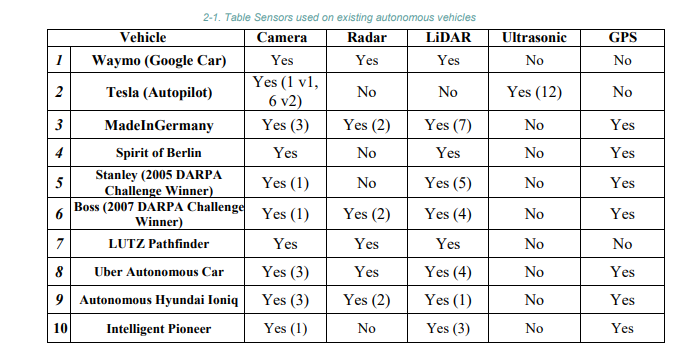Lesson 4: OVERVIEW OF SENSORS USED IN AUTONOMOUS VEHICLES
In this lesson, we’ll explore how in the ever-evolving realm of autonomous vehicles, a symphony of sensors orchestrates the precision and safety required for self-driving cars to navigate our roads.
1. Introduction
Autonomous vehicles rely on a multitude of sensors and controllers to navigate, make decisions, and ensure the safety of passengers and pedestrians. In this lesson, we will provide an overview of the various sensors commonly used in autonomous vehicles, including cameras, radar, LiDAR, ultrasonic sensors, and Global Navigation Satellite Systems (GNSS). Understanding these sensors is essential for grasping how autonomous vehicles perceive their surroundings and make informed decisions.

2. Radar
Radar, which stands for Radio Detection and Ranging, is a sensor that uses radio waves to detect and track objects. Initially developed during World War II for military applications, radar has become a cornerstone of modern autonomous vehicles. Here’s an overview of radar in autonomous vehicles:
- Operating Principle: Radar emits radio waves, which bounce off objects and return to the sensor. By analyzing the return waves, radar can determine the direction, distance, and size of detected objects.
- Types of Radar: There are two basic types of radar used in autonomous vehicles: return wave detection radar and Doppler radar. Return wave detection radar determines object positions, while Doppler radar can also estimate their speed.
- Advantages: Radar operates effectively in various lighting conditions (day or night), severe weather (rain, fog, snow), and at high speeds. It can measure longer distances (up to 250 meters) and is reasonably priced for mass production.
- Limitations: Radar can have difficulty measuring distances to non-metallic objects and has a relatively narrow beam. It’s sensitive to certain interferences and is less effective in very low-speed situations.
3. LiDAR
LiDAR, short for Light Detection and Ranging, uses laser beams instead of radio waves to detect objects and measure distances. It’s particularly known for its high resolution and its use in 3D mapping. Here’s an overview of LiDAR in autonomous vehicles:
- Operating Principle: LiDAR emits laser beams, and when they strike objects, they bounce back to the sensor. By measuring the travel time of the beams, LiDAR calculates distances.
- Key Features: LiDAR can capture a high-resolution 3D environment and detect non-metallic objects. It often consists of a laser diode, a photodiode, and a movable mirror.
- Advantages: LiDAR excels in creating detailed 3D maps, making it valuable for precise localization and navigation. It also works well in environments where satellite navigation isn’t available.
- Limitations: The high cost of LiDAR is a significant hurdle for its widespread use. It’s also sensitive to weather conditions like rain, snow, and fog.
4. Ultrasonic Sensors
Ultrasonic sensors use high-frequency sound waves to detect objects and measure distances. They are widely used in parking assistance systems and other automotive applications. Here’s an overview:
- Operating Principle: Ultrasonic sensors transmit sound waves and calculate distances based on the time it takes for the waves to return after hitting an object.
- Advantages: Ultrasonic sensors are affordable, work well in various weather conditions, and can detect non-metallic objects. They are commonly used in parking assistance systems.
- Limitations: Ultrasonic sensors have lower resolution and range compared to other sensors. They are less effective at high speeds and can be affected by external noise and environmental factors.
5. Cameras
Cameras have a long history and are essential in autonomous vehicles for capturing visual data. Here’s an overview of cameras in autonomous vehicles:
- Operating Principle: Cameras passively receive and capture light waves to create images and videos. They provide a wide range of visual information, including colors.
- Components: Cameras typically consist of optics, image sensors, and image processors. They are used in various driver assistance systems and for capturing visual data.
- Advantages: Cameras offer rich visual data, including traffic lane detection, traffic sign recognition, and more. They are cost-effective and widely available.
- Limitations: Cameras are sensitive to ambient lighting and weather conditions. They perform poorly in direct sunlight and are significantly affected by rain, snow, and fog.
6. Global Navigation Satellite Systems (GNSS)
Global Navigation Satellite Systems (GNSS) like GPS are used for location tracking and navigation. They have revolutionized autonomous vehicle navigation. Here’s an overview:
- Operating Principle: GNSS relies on signals from satellites to determine the precise location of a receiver on Earth. It uses trilateration to calculate position.
- Key Systems: GPS, Galileo, GLONASS, and BeiDou are examples of GNSS systems used globally.
- Advantages: GNSS provides accurate positioning information and is widely available. It’s used for navigation, route planning, and real-time traffic updates.
- Limitations: GNSS requires a stable and direct signal between the receiver and satellites, making it less effective in confined spaces and areas with signal obstructions.
Conclusion
- Autonomous vehicles rely on a multitude of sensors, including cameras, radar, LiDAR, ultrasonic sensors, and global navigation satellite systems (GNSS), to perceive their surroundings and navigate effectively.
- Each sensor type has its advantages and limitations, with cameras offering rich visual data but sensitivity to lighting and weather conditions, radar providing reliable long-range detection, LiDAR offering high-resolution 3D mapping, ultrasonic sensors being cost-effective for close-range detection, and GNSS enabling global positioning but with limitations in certain environments.
- The combination of these sensors and their integration into autonomous vehicle systems allows for robust perception, accurate localization, and safe navigation.
- Ongoing advancements in sensor technology, including the development of LiDAR without moving parts and improvements in GNSS accuracy, continue to drive the progress of autonomous vehicles.
- As autonomous vehicles become more prevalent, the sensor landscape will continue to evolve, potentially leading to even safer and more capable self-driving cars in the future.
